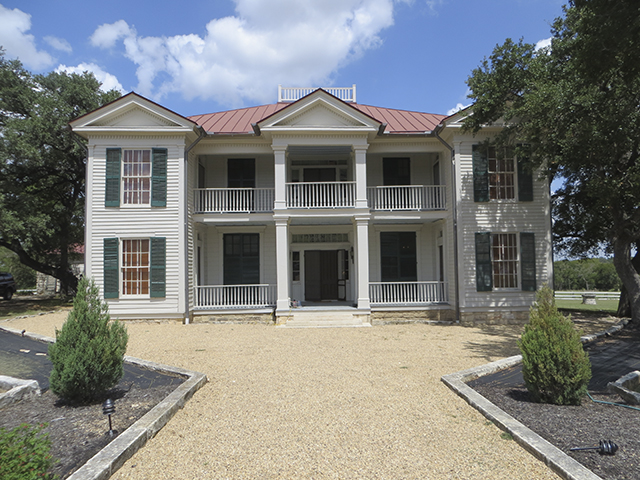Frontier mansion will be open for Gala event on Dec. 3, will be stop on Christmas Homes Tour on Dec. 4-6
They know the tinner’s name who did the standing seam roof.
They know who made the 11,000 shingles for the original barn.
The windows, sashes and shutters came from Houston.
They have records of just about everything.

“The Colonel didn’t throw away anything,” stated restoration specialist Gregory Free five years ago when he was leading the research into and restoration of Salado’s Robertson Plantation, acting on behalf of the sixth generation of the family that had such a great influence on Salado.
But what Free doesn’t yet know is simple: who designed the antebellum mansion.
The frontier mansion was built near the banks of the Salado Creek less than a decade after the last known Indian raids in central Texas.
“We don’t know who the architect was,” Free said about what is perhaps Salado’s best and least-known resource.
The Robertson Plantation was built by Col. Elijah Sterling Clack Robertson in the late 1850s. Construction on the main house finished in 1860, built of siding from the Lost Pines area of Bastrop.
The slave quarters, stable and kitchen/smokehouse/dining area were built of the ubiquitous native limestone of the area. “It was plentiful and cheap because it did not have to be transported,” Free said.
Other materials, including the metal roof, the windows (about 56 of them) and the siding were transported overland from Houston and other areas.
Free spoke about the challenge of building a home of this stature in this area which was not much more than frontier at the time.
“Colonel Robertson was dedicated to what he envisioned Salado to be,” he said, “and invested himself in that manner.”
That investment of time, money and labor — slave labor as the place was a Plantation — has stood near the banks of Salado Creek since then.

Free said that because the property has remained for more than 160 years in one family, it has been well kept for the most part.
Its history has been well chronicled and kept by the descendants.
During the Depression, the Robertson Plantation was studied in-depth as part of a works program called the Historic American Buildings Survey. Of the homes in Texas that were part of that survey conducted from 1936 to 1940, the Robertson Plantation was the most drawn in detail and number. Architectural drawings (some to scale) exist of all the details of the home and outbuildings. In fact, all of the moldings are drawn to scale, Free said.
Free said that while the name of the architect of the Plantation is not known, the style is more French Colonial than Palladian.
Pointing to the small rooms on either side of the front and rear recessed galleries — cabinets, as they were called, Free said that design is more likely to be found in the colonial architecture of West Africa and Louisiana than in the rest of the south. The Robertson Plantation has eight cabinets, or small rooms, in its symmetrical design.
The small rooms served as an office, stranger’s rooms, dressing rooms and later, with the advent of indoor plumbing, bathrooms.
The symmetrical design of the main house is Greek Revival in essence. The small rooms on each side are reminiscent of Palladio’s out buildings on either side of the main house as are the three triangular cornices of the roofline. These were hints at the architecture of the Robertson Plantation that the late Lucile Robertson shared with me some 27 years ago when she first gave us a tour of the grand place.
Whether it is Greek Revival, Creole-influenced, Palladial or a mixture of several influences, the Robertson Plantation is certainly Salado’s Grand Dame. She will open her doors to the public this winter for a Gala affair on Dec. 3 and for the Salado Historical Society Tour of Homes.
Sterling Ambrose and Cile Cowan invite you to experience the rich history of the place that their family has called home for more than six generations.
Salado Historical Society invites you to its annual Christmas Home Tour, which will be anchored by the historic Robertson Plantation. The tour will be open 5-8 p.m. Dec. 4, 10 a.m.-5 p.m. Dec.5 and 1-4 p.m. Dec. 6.
Tickets are $18 before Thanksgiving and $20 after Nov. 26. Tickets are pre-sold at the Visitors Center on Main Street and will be available at the tour stops during the first weekend of the Christmas Stroll, December 4-6.
Stops on the tour include the Robertson Plantation, the home of Dave and Barbara Swarthout at 11300 Stinnet Mill Rd., the home of Dena Parks at 800 Blaylock Dr. and the historic Boles-Aiken Cabin and Denman Cabin on Van Bibber, which were reconstructed at their current location by the Salado Historical Society. The cabins will be decorated for a traditional Christmas. Springhouse will decorate the cabins this year.
[…] The plantation house of his son, Col. Elijah Sterling Clack Robertson, who served with him during th… […]